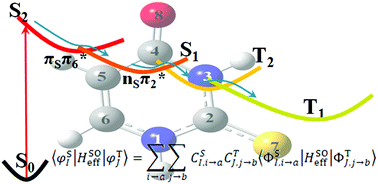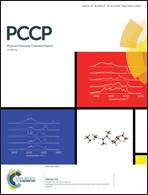Incorporating spin–orbit effects into surface hopping dynamics using the diagonal representation: a linear-response time-dependent density functional theory implementation with applications to 2-thiouracil†
Abstract
In this study, we present a trajectory surface hopping (TSH) method that incorporates spin–orbit (SO) effects using the “diagonal representation” within the Linear-Response Time-Dependent Density Functional Theory (LR-TDDFT) framework. In this approach, the evaluation of spin–orbit coupling (SOC) matrix elements between singlet and triplet states employs the Casida's wave functions and the Breit–Pauli (BP) spin–orbit Hamiltonian with effective charge approximation. The new TSH approach is then used to investigate the excited-state relaxation of 2-thiouracil (2TU) in vacuum and water. On the basis of the simulation results, relaxation of the initially populated bright state is found to be dominated by the route S2 → S1 → T. The intersystem crossing (ISC) can occur at either the C2-puckered structure or the C2-pyramidalized S1 minimum, and is promoted by a three-state near-degeneracy (S1/T2/T1 in vacuum or S1/T3/T2 in water) as well as sizable SOCs. Our simulations achieve a good agreement with the available experimental measurements in terms of the internal conversion (IC) and ISC time scales, and complement the picture of the relaxation mechanisms of 2TU after photo-excitation to the first bright state.



 Please wait while we load your content...
Please wait while we load your content...